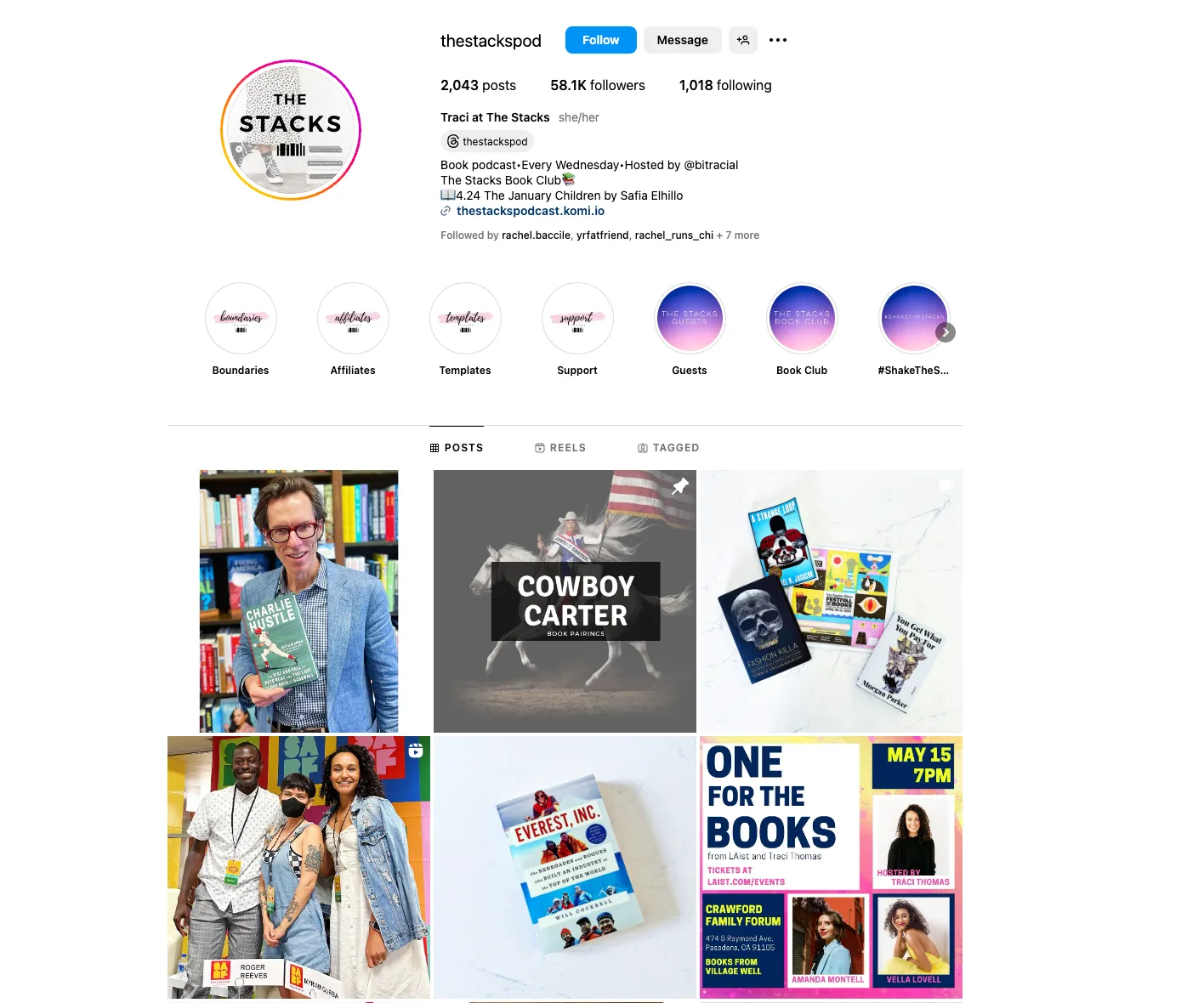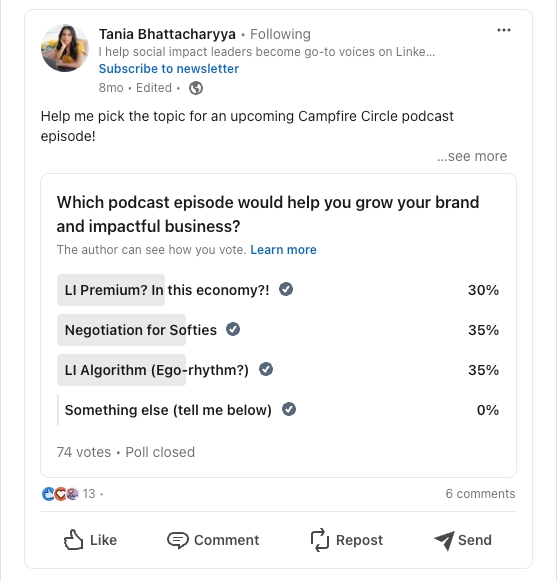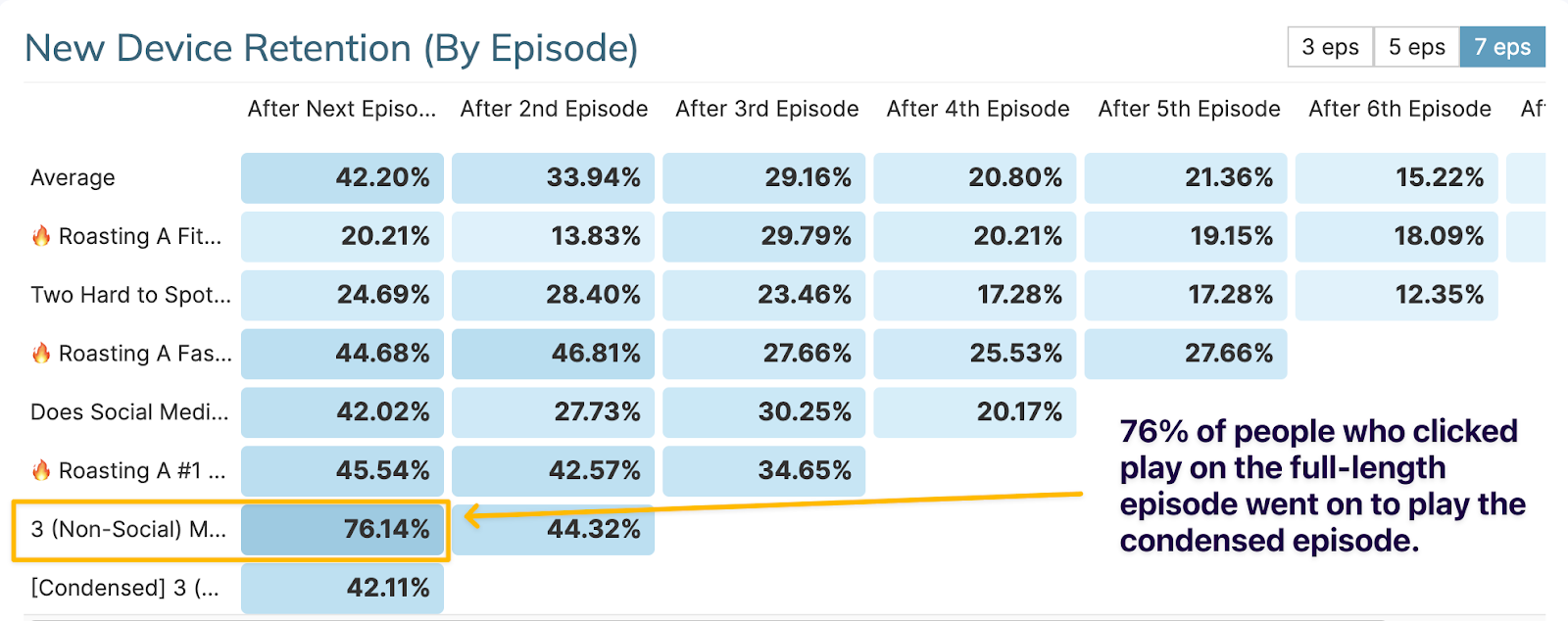Marketing your podcast can feel like juggling flaming torches—scary at first, but it’s not nearly as complicated once you get the hang of it. Sure, you’ve got to figure out social media, maybe dabble in PR, and contend with new marketing ideas almost every day. But the good news? There’s no single ‘right’ way to do it. In fact, you can keep trying fresh approaches until you find the ones that click. From social posts and teaser videos to PR blitzes and tapping your listeners’ networks—pick what works for you.
A quick review of podcast marketing basics
Before we dive into the details of what other podcasters are trying for their own shows, here’s a quick review of some of the most popular podcast marketing tactics.
Social media is an easy way to dip your toes into podcast marketing. You can start simple by publishing an image, such as an headshot of your guest or a quote from the episode, and the link once it goes live.
When you’re ready to improve on your efforts, consider posting audiograms—clips from the episode that encourage listeners to come back for more—in either an audio-only or video format. You could also try doing teaser reels the day before an episode drops or follow-up live videos with guests the day after an episode is live.
Content creation also works well as a form of podcast marketing. By publishing blog posts, posting your transcripts, and putting a video version of your show on YouTube, you’re tapping into the power of podcast SEO outside of the podcast players. You can also use your email newsletter to promote your podcast.
And let’s not forget the good ol’ power of relying on other people for podcast promotion. If you host a show with guests, you can ask them to share their episodes. You can also tap into the networks of other hosts by doing promo swaps, feed drops, or participating in podcast parties.
Only when you've exhausted those (free!) avenues should you start to think about buying ads for your podcast. You can choose from buying Google ads, social media ads, or even placing ads directly in podcast episodes or podcast apps.
While those are some of the most popular methods of podcast marketing, remember that experimenting and testing may get you even farther. You just have to be curious and willing to try something new.
Below are 22 podcast marketing tactics real podcasters are testing out. See which ones resonate with you!
Social media marketing for podcasts
Let’s start with social media podcast marketing—one of the easiest ways to share about new episodes. Here’s what a few podcasters are doing to market their podcast on social media.
1. Create an Instagram account for the show before starting a podcast
Traci Thomas of The Stacks podcast: "Before I ever released an episode, before I ever recorded an episode, I went on Instagram. I knew there was this book community there, and I made a book account for The Stacks and started engaging with people who were posting about similar books — commenting, DMing and becoming friends with people. That account had over 2,000 followers before the first episode ever came out. And I at least knew some of those people would listen, just because we'd become friendly and I'd recommended books to them or whatever."
 |
2. Involve your social followers
Chelsea Devantez of Celebrity Book Club (now Glamorous Trash): "It started on my Instagram, when I was posting these stories. A real digital book club started coming together before the podcast ever launched 'cause it took so long. So basically, I post book stuff, and I get tons of DMs responding to it. Then I would post the DMs, and people would respond to those DMs. So it was like, you're reading other people's thoughts. Other people are pitching in. Book clubs can't be based on one person. That has to be a group. "
That sense of community can skyrocket when you give your fans a reason to interact—try inviting them to vote on topics via polls, or offer exclusive content they can unlock with a simple share or tag. The more your followers feel personally involved, the stronger their connection to your show.
3. Use LinkedIn polls to determine what listeners want
Tania Bhattacharyya of the Campfire Circle podcast: "One memorable marketing test to grow podcast listenership was a LinkedIn poll with a follow-up strategy. I created a poll with three podcast episode topic options, including descriptions of each one. 74 people voted in the poll! Interestingly, the three options were evenly matched at 35%, 35% and 30%. So, I decided to record all three topics. As each new episode launched, I went back to the poll and sent a DM to each person who voted for that specific episode to thank them for voting and ask if they wanted me to send them the link to listen. I think this test worked because it created listener buy-in, as well as a direct connection to me to build the relationship and resonance. Sure, it took a little time and manual work, but it's always well worth it to be in community!”
 |
4. Set up a Discord channel to build community
Drifting Off with Joe Pera chose to set up a Discord for the show. Producer Grant Farsi said, "We set up the Discord...about three or four months into the launch of the podcast. That has helped a lot with building a community. That’s something that we’re constantly updating—like, setting up the channels, that's always an ongoing task. I think people appreciate a chance to come together around something."
Composer Ryan Dann adds, “I watch the Discord occasionally, and people who are fans of Joe's work and of the show often have other interests in common—they do woodworking, they do gardening. So the Discord is a great place to find other people that like the sort of the stuff that you like. That's been nice, watching people post pictures of what they grew this summer, or places they've been.”
Podcast marketing with a PR approach
There’s a lot that podcasters can learn about visibility from the public relations field. When it comes to marketing your podcast, here are a few PR ideas to get you started.
5. Apply for podcast awards
Heather Li of It's Nice to Hear You: "The thing that really helped was getting the Third Coast award. Then people started reaching out to me. Then it was easier.” [Did you nominate yourself for that?] “Yeah, that was a tactic. I applied to a bunch of awards, maybe 10."
 |
6. Hire a publicist
Molly Lambert of Heidi World: "I did something I had never done before: I hired a publicist. I had asked around; I was like, what did other people do to get their shows going? And I found out other people had hired publicists. So I used some of what I got paid for Heidi World to hire publicists out of my own pocket."
7. Pitch your podcast for features
Simon Parkin of My Perfect Console: “I wrote to Apple to try and get it featured quite early on. I knew I had a guest, Phil Fish, who made the video game Fez; he was one of the main characters in Indie Game: The Movie. And then he disappeared from the public eye completely. I knew him a bit and said, 'Would you come on and do an episode?' And he said yes. So I knew that that was going to be a big deal for people who are into the scene. I wrote to Apple and like, I think this would be a really good episode for you to promote. And they were really supportive and were like, 'Great, we'll do it.'"
8. Guest on other podcasts
One of the ways I market my own show is by being a guest on other podcasts. When hosts ask me if I have anything I’d like to promote on their shows, I don’t ask them to mention lead magnets or other business marketing assets during the episode. Instead, I ask them to introduce me on the episode as being the host of the Talk Copy to Me podcast.
Then, I make sure to show up prepared for each interview to share my copywriting, content marketing, and SEO expertise and insights with the host’s audience. Doing this ensures the host is pleased with the end-result of the episode, and it also means I’m going to actually be presented as an expert on air.
I’m not leaving anything to chance: If they feel good about me after hearing the episode, it’s a natural transition to move right over to my show in their podcast player after they’ve finished with the episode. And hopefully they’ll follow my show and leave a review at the same time!
Advertising as part of podcast marketing
Another form of marketing is paid (and free!) advertising, and there’s a few different ways you can advertise as a podcast host. If you’re looking to invest, consider paid advertising opportunities on Google, social media, or natively in the podcast apps themselves.
Alternatively, you can record your own ads as part of an ad swap with another host. Here’s how other podcastsers are using advertising in their podcast marketing.
9. Buy podcast ads
Angie Trueblood of Pitched—Real Stories of Pitching Bold Ideas: “One podcast marketing strategy we tested was paying to place a 45-second ad spot for my podcast on other podcasts in specific niches through the Buzzsprout ads platform. We chose this strategy because ads have become more user-friendly and accessible over the last few years, and it's always appealing to expose podcast listeners to a new-to-them show while they are listening to a podcast.
While we did see an increase in listenership, I didn't have access to robust reporting data, which could have informed our optimization efforts. If we leveraged this strategy again, I'd likely plan a more targeted approach and personalized campaign with 3-5 specific shows.”
10. Buy social media ads
Meg Brunson, host of the Just Marketing podcast says, “As a Facebook Ads Expert, I knew I wanted to leverage Facebook and Instagram ads to grow my podcast. I developed three strategies to test, and after some initial ad spend, I expanded the test to run a small case study with nine podcasts of various sizes—some big names you likely know, and some smaller, niched shows.
What I discovered is that Facebook ads can cause an initial bump in listenership, but they don’t necessarily result in long-term listener growth. Moving forward, we’ll focus our social media ad energy on lead-generation initiatives and promote the podcast through other channels. Focusing our ads on a lead generation campaign will help to get more people on our list. We'll then be able to build relationships with them while promoting the podcast via our email newsletters.”
Create or repurpose content for podcast marketing
As a marketer myself, one of my favorite ways to promote my show is by reusing content from my episodes in different mediums, such as in email newsletters or on social media or to create new content, like blog posts or even case studies. But that’s not the only way to create, reuse, or repurpose podcast content. Here’s how some podcasters are approaching podcast marketing from the lens of content creation.
11. Do roundups of old episodes in blogs and social posts
Lorraine Ball, host of More than a Few Words podcast, says "I leverage the power of my podcast archive by putting together collections of related interviews and use them in different ways. For example, I create blog posts with multiple episodes embedded. Sometimes I will repost the collection as an article on LinkedIn or Medium. Of course, the collections also work extremely well in newsletter format.
Recently, I've been experimenting with carousels for Instagram or short video collections on YouTube as curated episode collections. After I've created this content, I promote the collection and let the guests know when it's live. It gives me a chance to tag former guests on social media who in turn share the collection. Plus, it gives me the opportunity to reconnect with them as well."
 |
11. Create roundups of previous episodes in blogs and social posts
Emily Aborn of Content With Character and She Built This: "For the past five years, I've been using email marketing in various ways to promote my podcasts. I've included both podcasts in the newsletter as sort of a "roundup," as well as done one-off emails to promote episodes. It's definitely worked to keep my podcast top-of-mind and it allows people to tune in when episodes feel relevant for them.
Where I've landed after trying all sorts of different things is to repurpose the content in my podcast each week as a natural lead in to listening. I often start with a story, tip, or takeaway from the episode and then share links to the episode and/or extended blog if I've written one to go with it. I read my emails to people—by including an optional audio clip to listen versus reading the email—so my community gets a chance to hear me and get to know me through my voice prior to downloading my episodes. For a person who prefers listening to reading, it's a natural jump to go download an episode!"
13. Ask listeners to submit their own content
Ellen Scanlon of How to Do the Pot: "I was trying to think about the biggest challenge that cannabis brands face in getting new consumers. You still have to buy weed through a dispensary. That is the biggest challenge for a lot of people. And so I was like, what if we just started a series where I asked people to tell the story of the first time that they bought legal weed, and we'll put it on the air? I need to get some downtime, where I have an episode that can go out [that I’m not on]. Because this weekly pace is very strong.
So we started asking on our socials; we sent it out to a couple people we knew. This was 2021; I still have stories now that I haven't put on the air yet. Tink [Media] loved it from the beginning, and their love for it helped me to see how valuable it is because it's a collaboration with our listeners. Everyone who's been on a podcast wants to tell at least one friend."
 |
14. Create promo content for guests
Brittany Herzberg of The Basic B podcast: "Something I do to support my podcast growth is to provide marketing assets to my guests so they can also promote the show. I create a shared Google Folder and provide one tall video clip for a Reel or TikTok video, one static image, and swipe copy. This helps me expose my show to their audiences when they promote their guest appearances.
I highly encourage other podcasters to do the same, because you’re already creating assets to promote the episode for your own social media and email marketing, so why not take one extra step and share it with your guests?"
15. Post short form video content
Evan Lian of Two Dudes Watch Cartoons: "Video, specifically short-form, has been the main driver of our show's growth over the last year and a half. With some fairly consistent posting, we've built a modest audience on TikTok (5600+ followers) and accumulated hundreds of thousands of views and likes, just by posting short clips from each of our episodes."
16. Add video to your podcast episodes
Ashley Hamer of Taboo Science: "[I started producing video episodes and I optimized my YouTube channel:] I created a YouTube banner. I marked my podcast trailer as the channel trailer. I created a podcast playlist. And I started making custom YouTube thumbnails and YouTube-style titles for every video instead of just repurposing everything from the audio episode.
And wouldn’t you know it? When it looks like the lights are on and somebody’s home, people are more likely to subscribe to your channel. As a result, over a season of 13 video episodes (plus some audiogram reruns), my [YouTube] subscribers shot up from 34 to 370: a more than 10-fold increase.”
Getting help with your podcast marketing
Here’s a common misconception when it comes to what podcasters think about marketing their shows: You don’t have to do it all on your own. Other people can help you promote your show. Here’s how some podcasters are encouraging their audience and their network to help them share their new episodes.
17. Ask other hosts to help you promote the show
18. Let listeners know how they can help you
18. Let listeners know how they could help you
Becca Rich of Not Too Productive: "Something I do in every podcast is asking my audience for their support. Either at the beginning or the end of the episode, I’ll simply let them know the ways they could support the show, such as leaving a review, sharing the episode on social media, or subscribing to the show, and then I make sure to sincerely thank them for their help. This has helped me grow a community of genuine people who often reach out and tell me how much they appreciate me—which to me is the most important thing I can do as a service provider and a podcast host.”
A few more marketing tactics to consider
Not every marketing strategy fits in a category. Here are a few different options, such as SEO, gamification, and experimenting, that could work for you too.
19. Use SEO for your podcast
Robyn Graham, host of The Robyn Graham Show—Success Without Social, says: "SEO has been my go-to strategy for growing the podcast to a top 1% globally ranked show. Strategies include writing an SEO blog, Pinterest marketing, and posting shows on YouTube. Since Pinterest and YouTube are search engines, they've been an integral part of our marketing strategy, using keywords and key phrases to drive traffic."
20. Mimic what big companies are doing
James Kim of Moonface: "Moonface was like, I'm putting in my own money. I really need to think of a way to make sure that it counts. And so I looked at what A24 was doing, with how they're marketing their films, and other indie companies like Searchlight. I was like, the audience that I want is people who really like indie cinema. So I'm just going to mimic the approach that these other companies have, obviously with zero marketing budget.
How do you do that? The biggest thing for me was the trailer. That's the thing that makes me decide, personally, if I'm going to watch a film. I always thought with audio trailers, they never fully hooked me. So I decided to do the video trailer route. It wasn't as common at the time to release a video trailer in 2019."
21. Try different episode formats
Jeremy Enns of Podcast Marketing Trends Explained tested out different episode lengths to see what his listeners liked: “This week's audio episode was 57 min and the YouTube version was 37 min. Since we already had these two versions, I got curious: What would happen if we released both versions on the podcast feed? On Tuesday, I released both versions with a short DAI [dynamically inserted] pre-roll explaining the setup. So far, it's been interesting to see that each episode has very similar download numbers with an ever so slight preference for the shorter ‘Condensed’ episode.”
 |
Even more interesting, however, has been what Chartable's unique device retention data has shown: That longer-term listeners tend to (slightly) prefer the longer, full-length episode, while new listeners prefer the condensed episode."
22. Use local events to promote the show
Yamini Ranjan, host of the Women of Wayland podcast: “I run a seasonal podcast, and I use local events as part of my marketing efforts. One example involves community gamification. I just released the first episode of season 4, and my guest is a local award-winning author. I hid her latest book in little free libraries around Wayland to get more interest from the communities around us. I also throw in-person events like podcast socials where listeners can meet the guests. It's a unique event that helps connect listeners to their guests and spread the word.”
Frequently asked questions about podcast marketing
What is podcast marketing?
Podcast marketing is a method of promoting your show to continue to grow your audience, keep current listeners coming back for more, and sustain the efforts you’re putting into producing your show.
Is podcast marketing worth it?
Podcast marketing is absolutely worth the effort you put into it. It takes some testing, adjusting, and then even more experimentation to see what will work well for your show, but when you find the thing that pays off, it's worth the effort in the end.
How do I make my podcast go viral?
There's no surefire way to make your podcast go viral. My best suggestion is to focus on creating the best episodes possible and marketing them well. Try guesting on other podcasts, making social clips, and even hiring a PR agency to spread the word about your show and hopefully hit that viral moment.
How do you create a marketing strategy for a podcast?
Start by getting crystal clear on your goal—maybe it’s to reach a niche community or build a massive subscriber base. Next, figure out where those potential listeners hang out. Are they scrolling endlessly on TikTok, catching updates on LinkedIn, or lurking in a subReddit? Focus on the platforms that naturally fit your show and demographic. Then, commit to a consistent production schedule, so your audience knows when to expect new episodes. Try out different promotion tactics—like sound bites on social or guest appearances on other podcasts—and pay attention to what sticks. If an approach falls flat, toss it and move on. Over time, you’ll see the patterns that grow your show most effectively.
How do I get 1,000 listeners for my podcast?
Answer (simplified): Focus on consistent, high-quality episodes and clear branding for your show. Encourage audience engagement by asking for reviews and word-of-mouth recommendations—people trust personal suggestions. Use social media or a newsletter to share clips or teasers that highlight your best segments. Consider collaborating with fellow podcasters to cross-promote and reach new listeners. Over time, these small steps add up, helping you hit—and surpass—1,000 listeners.
Why Add It:
SERP Signal: Addresses a common milestone question (How do I get 1000 listeners for my podcast?)
Content Gap Filled: Offers a practical strategy for early-stage growth.
How much does a 30-second ad cost on a podcast?
Answer (simplified): Many podcasters use a cost per thousand (CPM) model in the range of $20–$40 for a 30-second ad. For instance, if your show averages 10,000 downloads an episode, a 30-second ad could run around $200–$400. Rates vary based on factors like audience size, niche, and listener loyalty, so consider your show’s unique reach when deciding on pricing.
Why Add It:
SERP Signal: Reflects a frequently searched query about ad pricing and ROI.
Content Gap Filled: Answers the cost question directly and concisely.

































%20(1).JPG)








